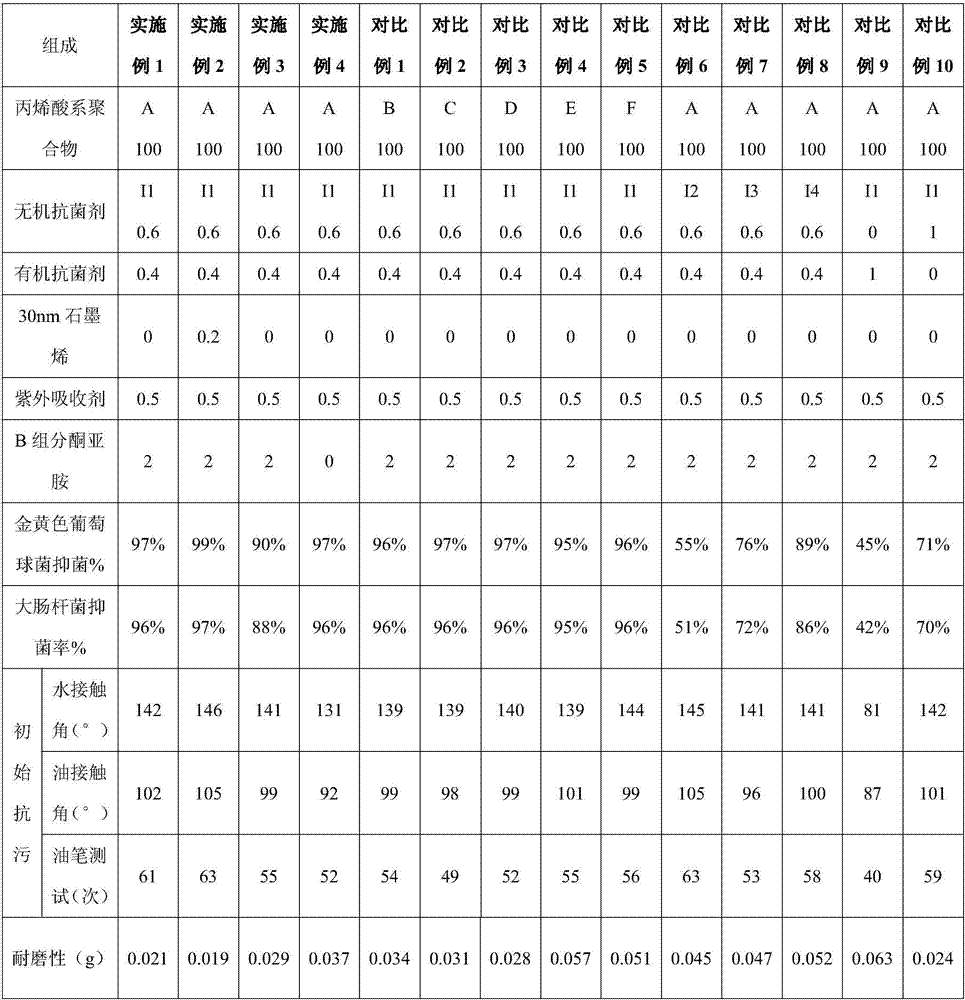Graphene based anti-bacterial and wear-resistant double-component coating as well as preparation method, application and use method thereof
A graphene-based, two-component technology, applied in the field of antibacterial, graphene-based antibacterial, wear-resistant two-component coatings, can solve the problems of antibacterial effect decline, unpleasant taste, difficult to control, etc.
- Summary
- Abstract
- Description
- Claims
- Application Information
AI Technical Summary
Problems solved by technology
Method used
Image
Examples
preparation example Construction
[0042] Coating preparation method
[0043] The preparation method of graphene base antibacterial, wear-resistant two-component coating, it comprises as follows:
[0044] Preparation of component A:
[0045] a, preparing an aqueous dispersion of acrylic polymer;
[0046] B, adding graphene-loaded titanium dioxide as an antibacterial agent and 2-propenyloxyethyltributylphosphorous chloride-trimethoxyvinyl silicon oligomer containing fluoroalkyl, stir evenly;
[0047] c. Add other additives and mix well.
[0048] Preparation of component B: component B is ketimine and can be packaged directly.
[0049] Use of paint
[0050] The application of the graphene-based antibacterial and wear-resistant two-component coating of the present invention in the painting of interior and exterior walls is preferably applied in the painting of interior walls of hospitals and schools. When the present invention is in use, it is coated on the body of wall, and is preferably irradiated with ultr...
specific Embodiment approach
[0058] In order to make technical personnel understand the technical solution of the present invention more intuitively, several typical embodiments are selected below for introduction. These embodiments do not constitute a limitation to the protection scope of the present invention. Any solution that does not deviate from the inventive concept is within the protection scope of the present invention. .
preparation example
[0060] 1. Acrylic polymer
[0061] Acrylic polymer A: composed of acrylic polymer aqueous dispersion liquid by 22 parts by weight of butyl acrylate, 8 parts by weight of methyl acrylate, 6 parts by weight of epoxy acrylate, 5 parts by weight of hydroxyethyl acrylate, The 2-phenylethyl acrylate of 14 parts by weight, the calcium carbonate of 6 parts by weight, the glass microsphere of 14 parts by weight, the silane coupling agent of 1 part by weight, the tensio-active agent of 2 parts by weight, the initiator of 2 parts by weight and 120 parts by weight of water, the above-mentioned components were polymerized by free radicals to obtain an acrylic polymer A.
[0062] Acrylic polymer B: composed of an acrylic polymer aqueous dispersion consisting of 25 parts by weight of butyl acrylate, 11 parts by weight of methyl acrylate, 5 parts by weight of hydroxyethyl acrylate, and 14 parts by weight of acrylic acid-2-benzene The calcium carbonate of ethyl ester, 6 weight parts, the gl...
PUM
 Login to View More
Login to View More Abstract
Description
Claims
Application Information
 Login to View More
Login to View More - R&D
- Intellectual Property
- Life Sciences
- Materials
- Tech Scout
- Unparalleled Data Quality
- Higher Quality Content
- 60% Fewer Hallucinations
Browse by: Latest US Patents, China's latest patents, Technical Efficacy Thesaurus, Application Domain, Technology Topic, Popular Technical Reports.
© 2025 PatSnap. All rights reserved.Legal|Privacy policy|Modern Slavery Act Transparency Statement|Sitemap|About US| Contact US: help@patsnap.com

